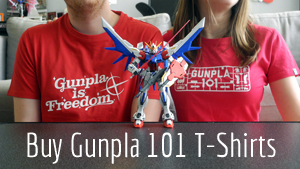
Step Up Your Gunpla is a new series of tutorials that Gunpla 101 contributor Nanochi has designed for builders who want to bring more pizazz to their kits. Previously: Skirt Armor.
If you’ve been building Gunpla for a while and are looking for a new challenge, you may want to tackle painting your own kits.
There’s a definite learning curve when it comes to painting, which is why previous tutorials here on Gunpla 101 have advocated starting slowly, testing paint primer on plastic spoons, only using paint markers, or just painting decals (instead of using stickers) to begin with.
However, one tip it’s important to learn early is how to prepare paint for model-building. Whether you’re painting a little or a lot of your kit, it’s important to get paint to evenly distribute, rather than being streaky in some places (where it’s too thin) and gloppy in others (where it’s too thick).
The trick is to remember that paint pigment always settles at the bottom of the bottle when the paint is not in use. Today, I’ll show you a simple method to always get your paint pigments to be evenly distributed, as I used for my Perfect Grade Gundam Mark II.

First, let me share a bit of general information about why this is important for your Gunpla. Have you ever painted a room in your house and wondered why the store gave you a wooden paint stirrer when they sold the paint to you? All paint, whether for home use or model use, is made up of multiple ingredients, and these ingredients tend to separate over time.
Model paint includes three different ingredients:
- Pigment: this gives the paint its color and opacity. The amount of pigment governs the intensity of the color as well as its ability to cover what it is painted over.
- Binder: this makes the pigment particles stick to each other as well as the surface of whatever you are painting. It also determines how quickly the paint will dry.
- Liquid (also called solvent, carrier, or dispersant): since pigment is usually a powder and binder is often a thick paste, most of the paint ingredients fit into this category, which is designed to thin the paint into a useable surface coat.
Since pigment begins as a solid, it tends to settle at the bottom of the paint mixture when not in use. If you ever put your brush in a jar that hasn’t been used for a while, you will notice that the bottom is a bit more solid than the rest of the paint.
Acrylic or water-based modeling paint tends to have more pigment than other kinds of paint, due to the discerning standards of modelers. So to mix it up again, just using a stirring stick won’t cut it.
You know when you shake a can of spray paint, you can hear something rolling around? After I looked up that there’s a ball in there to help mix the spray paint ingredients, I got the idea of using BB pellets in hobby paint. On a hunch, I tried the following, and it worked quite well:
 First, buy some BB pellets. Yes, the kind you can put in a BB gun.
First, buy some BB pellets. Yes, the kind you can put in a BB gun.
Next, open your jar of hobby paint. Make sure the sides of the jar lid are clean and put in 5-10 bbs in the jar depending on the size. For these bigger Tamiya paint jars, I tend to put in around 20 or so each.
Now, seal the jar and start shaking. Wait until you hear the BBs bounce against the sides of the jar, and then shake for 20 more seconds. What you’re hearing is the BBs bouncing into the more solid pigment layer and shaking it up, distributing it evenly throughout the jar.
Once done, open the bottle up and your paint is ready to use.
 Please note you can NOT use process this for lacquer-based paint. The chemicals of the lacquer paint will react to the BBs and cause the paint itself to become unsalvageable. For these paints, it is best to use a hobby stirring stick. As for enamel paint, they don’t separate the same way and don’t need a tutorial like this one, which is best for acrylic and water-based paints.
Please note you can NOT use process this for lacquer-based paint. The chemicals of the lacquer paint will react to the BBs and cause the paint itself to become unsalvageable. For these paints, it is best to use a hobby stirring stick. As for enamel paint, they don’t separate the same way and don’t need a tutorial like this one, which is best for acrylic and water-based paints.
This tutorial began as an experiment I tried, and now it’s something I always do to make sure my paints are mixed! I hope it helps you create more highly-pigmented builds as well.








4 Comments.
Do BB Pellets really work? average plastic ones aren’t very heavy, I just cant imagine them flowing through a bot of tamiya paint very well?
Happy to be proven wrong as I have a bag of them spare.
YOu can try the plastic bb pellets. Personally i dont think they will work as well since ive never tried them. To be honest I didnt know there were plastic ones till now, only knew of the metal ones.
Plastic may work for acrylic, but enamels have a stringer solvent and I would be cautious about leaving them in fluid paint for extended periods.
I’ve also had luck with simply using plastic toothpicks and stirring acrylics/enamels for no less than a minute. This works especially well with blues, which are thick with pigment, and prevents paint from leaching into the threads of the bottle/jar cap.